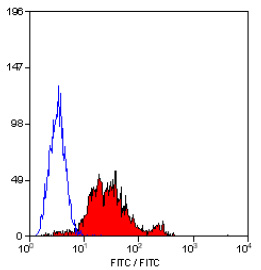Integrin beta 1 (ITGB1) Mouse Monoclonal Antibody [Clone ID: 4B7R]
Specifications
| Product Data | |
| Clone Name | 4B7R |
| Applications | FC |
| Recommended Dilution | Flow Cytometry: Use 10 µl of neat antibody to label 10e6 cells in 100 µl. This Clone 4B7R is reported to work on Immunohistochemistry on Paraffin Sections. |
| Reactivities | Human |
| Host | Mouse |
| Isotype | IgG1 |
| Clonality | Monoclonal |
| Immunogen | Ocular melanoma cell line V+B2. |
| Specificity | This antibody recognizes the Human beta 1 subunit of Integrin (CD29). Other species not tested. |
| Formulation | PBS, pH 7.4 Label: FITC State: Liquid purified IgG fraction Stabilizer: 1% BSA Preservative: 0.09% Sodium Azide Label: Fluorescein Isothiocyanate Isomer 1 |
| Concentration | lot specific |
| Purification | Affinity Chromatography on Protein G |
| Conjugation | FITC |
| Storage | Store undiluted at 2-8°C for one month or (in aliquots) at -20°C for longer. This product is photosensitive and should be protected from light. Avoid repeated freezing and thawing. |
| Stability | Shelf life: one year from despatch. |
| Gene Name | integrin subunit beta 1 |
| Database Link | |
| Background | Integrin beta 1, also known as CD29, is a 130 kDa transmembrane glycoprotein that forms noncovalent complexes with various Integrin alpha subunits (including alpha 1, alpha 2, alpha 3, alpha 4, alpha 5, and alpha 6, also known as CD49a, CD49b, CD49c, CD49d, CD49e, and CD49f, respectively) to form the functional receptors that bind to specific extracellular matrix proteins. Integrin receptors are involved in the regulation of a variety of important biological functions, including embryonic development, wound repair, hemostasis, and prevention of programmed cell death. They are also implicated in abnormal pathological states such as tumor directed angiogenesis, tumor cell growth, and metastasis. These heterodimeric receptors bridge the cytoplasmic actin cytoskeleton with proteins present in the extracellular matrix and/or on adjacent cells. The clustering of integrins on a cell surface leads to the formation of focal contacts. Interactions between integrins and the extracellular matrix lead to activation of signal transduction pathways and regulation of gene expression. In case of HIV-1 infection, the interaction with extracellular viral Tat protein seems to enhance angiogenesis in Kaposi's sarcoma lesions. |
| Synonyms | Fibronectin receptor subunit beta, Integrin VLA-4 subunit beta, ITGB1, FNRB, MDF2, MSK12 |
| Reference Data | |
Documents
| Product Manuals |
| FAQs |
{0} Product Review(s)
0 Product Review(s)
Submit review
Be the first one to submit a review
Product Citations
*Delivery time may vary from web posted schedule. Occasional delays may occur due to unforeseen
complexities in the preparation of your product. International customers may expect an additional 1-2 weeks
in shipping.






























































































































































































































































 Germany
Germany
 Japan
Japan
 United Kingdom
United Kingdom
 China
China



